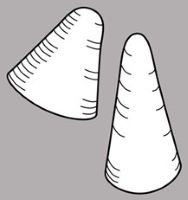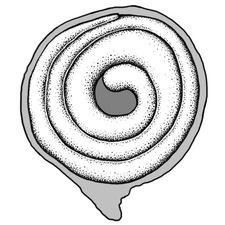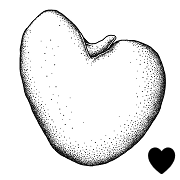Content is from Kirkbride et al. 2006Kirkbride et al. 2006:
Kirkbride JH, Jr, Gunn CR, and Dallwitz MJ. 2006. Family guide for fruits and seeds, vers. 1.0. Accessed September 2020-January 2022. URL: https://nt.ars-grin.gov/seedsfruits/keys/frsdfam/index.cfm ., without modification.
Updates are forthcoming.
Fruits: Fruit pericarpium; simple; drupedrupe:
(indehiscent drupe) a fleshy, indehiscent fruit with one more hard pits enclosing seeds, derived from single, superior, simple or compound ovary; (dehiscent drupe) a fruit with a dry or fibrous to fleshy or leathery outer husk that early to tardily breaks apart (or opens), exposing one or more nutlike pits enclosing the seeds (Spjut - though described as baccate, drupaceous, or nutlike by others); without persistent central column; within accessory organ(s), or not within accessory organ(s); within calyxcalyx:
(Spjut - though described as baccate, drupaceous, or nutlike by others); without persistent central column; within accessory organ(s), or not within accessory organ(s); within calyxcalyx:
the outer whorl of the perianth; all the sepals of a flower ; 1-seeded, or more than 1 but less than 10-seeded; 1–5-seeded; less than 1 cm long; 0.4–0.6 cm long; with Stylobasium 1–5-carpellate (Guilfoylia 2, Cadellia & Suriana 5); with carpels united; with carpels remaining united at maturity; with carpels not radiating at maturity; with carpels remaining connected at stylestyle:
; 1-seeded, or more than 1 but less than 10-seeded; 1–5-seeded; less than 1 cm long; 0.4–0.6 cm long; with Stylobasium 1–5-carpellate (Guilfoylia 2, Cadellia & Suriana 5); with carpels united; with carpels remaining united at maturity; with carpels not radiating at maturity; with carpels remaining connected at stylestyle:
in a flower, the narrow and elongated part of the pistil between the stigma and the ovary; sometimes persisting in fruit ; without sterilesterile:
; without sterilesterile:
lacking male and/or female reproductive parts; also, not producing fruit or seed
 carpels; not sulcatesulcate:
carpels; not sulcatesulcate:
surface relief—having one or more elongate, relatively narrow and shallow depressions or grooves ; in transection tereteterete:
; in transection tereteterete:
approximately circular in cross section; width and thickness approximately equal
 ; apexapex:
; apexapex:
the point farthest from the point of attachment, or the "tip" of an organ not beaked; indehiscentindehiscent:
not beaked; indehiscentindehiscent:
not opening on its own, as in a fruit
 . Epicarpepicarp:
. Epicarpepicarp:
outer layer of fruit wall or pericarp, if divided into layers; note here used synonymously with exocarp brown (all shades); durable; not glabrousglabrous:
brown (all shades); durable; not glabrousglabrous:
without hairs
(with hairs), or glabrousglabrous:
without hairs
; hairs dense; hairs not glandularglandular:
surface relief—covered with small, raised secretory glands, regular or irregularly shaped, translucent or opaque, and maybe distinctly colored ; without armature; without wing(s); without apicalapical:
; without armature; without wing(s); without apicalapical:
at or pertaining to the end of the seed or fruit distal from its point of attachment (i.e., base)
respiratory hole. Mesocarpmesocarp:
the middle layer of the pericarp, if divided into layers present. Endocarpendocarp:
present. Endocarpendocarp:
the inner layer of the pericarp, if divided into layers present, or absent; not separating from exocarpexocarp:
present, or absent; not separating from exocarpexocarp:
outer layer of fruit wall or pericarp, if divided into layers; note here used synonymously with epicarp ; hard; stone unilocular; without wing; without operculumoperculum:
; hard; stone unilocular; without wing; without operculumoperculum:
a dehiscent cap (or lid) of a seed or fruit that opens during germination or dehiscence ; without secretory cavities; without mechanism for seedling escape; without grooves; without longitudinallongitudinal:
; without secretory cavities; without mechanism for seedling escape; without grooves; without longitudinallongitudinal:
of or relating to length or the lengthwise dimension
ridges. Funiculusfuniculus:
(alt. funicle) stalk connecting the ovule (later seed) to the ovary (later fruit) placenta short; short without seed bearing hookswith hooks:
short; short without seed bearing hookswith hooks:
bristles or spines with curved or backwards pointing tips, or with secondary bristles along their length (retinacula); not persisting in fruit after seed shed.
(retinacula); not persisting in fruit after seed shed.
Seeds: Arilaril:
(broad sense) appendicular structure that wholly or partly envelops a seed and is produced from or a modification of the funicle, raphe, or outer integument; usually fleshy or pulpy, sometimes spongy or tufted-capillate, often brightly colored absent. Seed larger than minute; 1 to less than 5 mm long; 2 mm long; circularcircular:
absent. Seed larger than minute; 1 to less than 5 mm long; 2 mm long; circularcircular:
(of embryo) linear embryo is curved into an "O" shape , or ovateovate:
, or ovateovate:
2D shape—egg-shaped in outline, widest point is towards one end of the organ, the other end tapers gradually, attachment at or near the broad end (compare obovate, ovoid) ; in transection tereteterete:
; in transection tereteterete:
approximately circular in cross section; width and thickness approximately equal
 ; not bowl shaped; not nutlike; without winglike beakbeak:
; not bowl shaped; not nutlike; without winglike beakbeak:
a usually firm, terminal appendage, sometimes tapered ; without caudatecaudate:
; without caudatecaudate:
tapering to a long, tail-like appendage appendage(s); at maturity with food reserves, or without apparent food reserves; with endosperm; without canavanine. Sarcotestasarcotesta:
appendage(s); at maturity with food reserves, or without apparent food reserves; with endosperm; without canavanine. Sarcotestasarcotesta:
pulpy or fleshy outer layer of the seed coat, simulates aril absent. Testatesta:
absent. Testatesta:
seed coat
 present; without markedly different marginalmarginal:
present; without markedly different marginalmarginal:
at, on, or close to the margin or border
tissue; without fleshy or leatheryleathery:
texture—moderately thick, tough, and very pliable
layer over hard layer; tight; dulldull:
reflecting only a low proportion of incident light, with no apparent sheen , or shinyshiny:
, or shinyshiny:
uniformly reflecting a high proportion of incident light at all angles ; surface smooth, or unsmooth; surface with discreet raised features, or merged raised features; surface tuberculatetuberculate:
; surface smooth, or unsmooth; surface with discreet raised features, or merged raised features; surface tuberculatetuberculate:
surface relief—bearing small, warty, swelling, rounded, or variously shaped projections ; surface reticulatereticulate:
; surface reticulatereticulate:
surface relief—netted, raised walls or concave grooves forming a net-like surface pattern with flat, concave, or convex interspaces , or wrinkledwrinkled:
, or wrinkledwrinkled:
surface relief—shallow, irregular folds and furrows covering the surface; appearing overall though crumpled and then spread out ; without crease or line separating cotyledons from hypocotyl-radicle; with notch along margin where cotyledons from hypocotyl-radicle tip approaching each other, or without notch along margin where cotyledons from hypocotyl-radicle tip approach each other; without glands; without bristles; glabrousglabrous:
; without crease or line separating cotyledons from hypocotyl-radicle; with notch along margin where cotyledons from hypocotyl-radicle tip approaching each other, or without notch along margin where cotyledons from hypocotyl-radicle tip approach each other; without glands; without bristles; glabrousglabrous:
without hairs
; without wings; without collar; without operculumoperculum:
a dehiscent cap (or lid) of a seed or fruit that opens during germination or dehiscence ; colored; monochrome; yellow, or cream; not becoming mucilaginousmucilaginous:
; colored; monochrome; yellow, or cream; not becoming mucilaginousmucilaginous:
resembling mucilage; moist and sticky
when wetted; surrounding embryo. Endosperm development nuclear; scant; with starch, or without starch; with oils; without fatty acid containing cyclopropene; without apicalapical:
at or pertaining to the end of the seed or fruit distal from its point of attachment (i.e., base)
lobes; without chlorophyll; without isodiametric faceted surface; without odor. Embryo differentiated from food reserve; well developed; 1 per seed; completely filling testatesta:
seed coat
 (no food reserve), or nearly filling testatesta:
(no food reserve), or nearly filling testatesta:
seed coat
 (trace or scanty food reserve); 0.9–1 times the length of food reserve; at one end of seed not extending into a depression or cup; axileaxile:
(trace or scanty food reserve); 0.9–1 times the length of food reserve; at one end of seed not extending into a depression or cup; axileaxile:
on or of the axis
and centric; foliatefoliate:
appearing leaf-like
, or conicalconical:
3D shape—cone-shaped, with the point of attachment at the broad end (Suriana); with investinginvesting:
(Suriana); with investinginvesting:
(of embryo) embryo is nearly or completely filling seed coat, straight, and axile and centric with spatulate cotyledons and covering the stalk for at least half its length; (of cotyledons) cotyledons spatulate and covering the stalk for at least half its length
cotyledons, or spatulatespatulate:
2D shape—like a spatula; rounded at the apex, with base long and tapered; (of embryo) embryo is straight and axile and centric with the cotyledons expanded to form the shape of a spatula or spoon; (of cotyledons) cotyledons expanded and wider than the stalk but not invested into the stalk cotyledons; straight, or flatly coiledcoiled:
cotyledons; straight, or flatly coiledcoiled:
(of embryo) linear embryo is very long and bent to form a coil whereby one end of the embryo is on the outside and the other end near the middle of the seed (circinatecircinate:
(circinatecircinate:
3D shape—terete and rolled downward from the apex in a tight coil
) (Suriana), or annularannular:
3D shape—forming a ring ; 100% annularannular:
; 100% annularannular:
3D shape—forming a ring ; parallel to seed length; surrounding endosperm (Suriana); with cotyledons abruptly connected to hypocotyl-radicle, or gradually connected to hypocotyl-radicle; without coleorhiza; without simmondsin; with cotyledons containing oils and starch; without stomata; not green; with 2 or more cotyledons. Cotyledons 2; well developed; 0.9 times length of embryo; somewhat to significantly wider than hypocotyl-radicle, or as wide as hypocotyl-radicle; 1–10 times wider than hypocotyl-radicle; not concealing hypocotyl-radicle, or entirely concealing hypocotyl-radicle; foliaceous, or not foliaceous; thick, or thin (Cadellia); flat, or once-folded, or convoluted; smooth; with apicesapex:
; parallel to seed length; surrounding endosperm (Suriana); with cotyledons abruptly connected to hypocotyl-radicle, or gradually connected to hypocotyl-radicle; without coleorhiza; without simmondsin; with cotyledons containing oils and starch; without stomata; not green; with 2 or more cotyledons. Cotyledons 2; well developed; 0.9 times length of embryo; somewhat to significantly wider than hypocotyl-radicle, or as wide as hypocotyl-radicle; 1–10 times wider than hypocotyl-radicle; not concealing hypocotyl-radicle, or entirely concealing hypocotyl-radicle; foliaceous, or not foliaceous; thick, or thin (Cadellia); flat, or once-folded, or convoluted; smooth; with apicesapex:
the point farthest from the point of attachment, or the "tip" of an organ entire; with margins separate; basally cordatecordate:
entire; with margins separate; basally cordatecordate:
2D shape—heart-shaped, with attachment at or near the broad end (compare obcordate) ; equal in size; not punctatepunctate:
; equal in size; not punctatepunctate:
surface relief - dotted with pits or with translucent, sunken glands or with colored dots, similar to pitted dotted. Hypocotyl-radicle moderately developed to small; straight, or curvedcurved:
dotted. Hypocotyl-radicle moderately developed to small; straight, or curvedcurved:
(of embryo) linear embryo is curved into an arch or horseshoe with the ends far apart ; not thickened.
; not thickened.
Literature specific to this family: Correll, D.S. & H.B. Correll. 1982. Flora of the Bahama Archipelago. J. Cramer, Vaduz; Harden, G.J., ed. 1991. Flora of New South Wales, vol. 2. New South Wales University Press, Kensington; Juarez S., C. 1988. Surianaceae. Flora de Veracruz, fasc. 58, pp. 1–5.
General references: Baillon, H.E. 1866–95. Histoire des plantes, 13 vols. Hachette & Co., Paris, Cronquist, A. 1981. An integrated system of classification of flowering plants, 1,262 p. Columbia University Press, New York, Gunn, C.R., J.H. Wiersema, C.A. Ritchie, & J.H. Kirkbride, Jr. 1992 & amendments. Families and genera of Spermatophytes recognized by the Agricultural Research Service. Techn. Bull. U.S.D.A. 1796:1–500, LeMaout, E. & J. Decaisne. 1876. A general system of botany, 1,065 p. Longmans, Green, & Co., London, Mabberley, D.J. 1987. The plant-book, 706 p. Cambridge University Press, Cambridge, and Spjut, R.W. 1994. A systematic treatment of fruit types. Mem. New York Bot. Gard. 70:1–182.